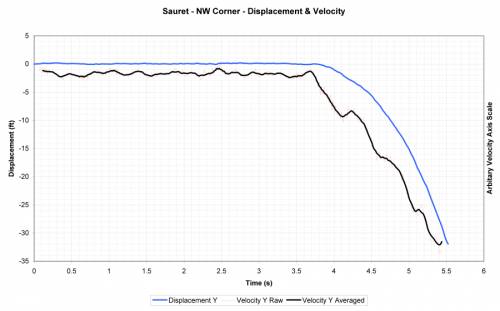There was deceleration, as shown by measurements and analysis by femr2 (who happens to be a "truther" . The bottom line is the measured velocity of the NW roof corner:
. The bottom line is the measured velocity of the NW roof corner:

So Tony Szamboti's claim that there was no "jolt" is false, and his later claim that it should have been larger is based on faulty logic. Specifically, Tony claims that if the scenario used in Bazant's analysis is an accurate description of what happened, then there should have been a large deceleration caused by the "force amplification" necessary to buckle the columns. No jolt of the "expected" magnitude was observed, says Tony, so that scenario must not be an accurate description of what happened. Well, duh, anyone who actually understood Bazant's analysis already knew that, because that was never the intent. The analysis was based on a one-dimensional model in which the upper block had gravitational potential energy by simply being 13 feet higher than the floors below, which was converted to kinetic energy by falling that distance. Bazant analyzed whether or not the columns below could have absorbed that energy without buckling. The analysis demonstrates that the energy was far more than the columns could have absorbed as strain energy. The conclusion is that even if all the columns had acted in unison to absorb maximum energy by compressing, they would have buckled and the collapse was bound to proceed. But we already know that the top block did not drop cleanly and impact column-on-column to allow that maximal energy absorption to happen. Bazant explicitly denied that that was a "realistic" scenario and mentioned other failure modes that certainly happened -- e.g. ripping floors away from columns -- but notes that those failure modes would have absorbed even less energy than column buckling, so total collapse was simply unavoidable.
Furthermore, even for columns that did buckle, the tilt of the top block meant that they didn't all buckle at the same time, so there's no reason to expect to see a single massive jolt of the top block: the "jolt" they collectively produced was spread out over time. But Tony simply ignored all the many reasons why the roof should not be expected to show the jolt he claimed, and instead continues to insist that magical silent explosives are the only possible explanation. If you're waiting for his arguments to be taken seriously in the engineering community, I predict you'll be waiting a long, long time.
The real significance of Bazant's analysis is that if anyone who wants to claim that the structure should have been able to halt the collapse, then they need to explain how all that energy would have been absorbed. If you don't understand why that's so, then you are in no position to be making claims about the physics of the situation. And if you don't have a valid explanation, then you don't have a case. And that's exactly where the "truth movement" is, despite many years of hand-waving claims based on imaginary physics by Richard Gage's "experts."
 = new reply since forum marked as read
= new reply since forum marked as read
